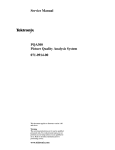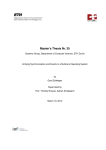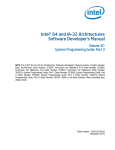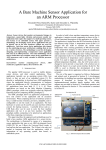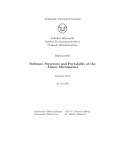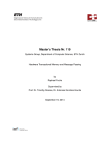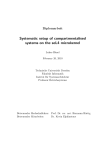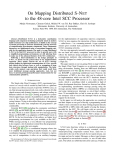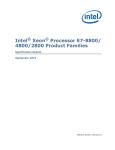Download Virtual Memory in a Multikernel
Transcript
Master’s Thesis Nr. 47
Systems Group, Department of Computer Science, ETH Zurich
Virtual Memory in a Multikernel
by
Simon Gerber
Supervised by
Prof. Timothy Roscoe
November 2011 – May 2012
Even though virtual memory is largely understood, and implementations perform well, in
a single core environment, with the advent of multicore processors we have a new set of
circumstances that the virtual memory system has to adapt to. As the trend of putting
more and more cores on a single chip is continuing, the true-and-tried single-core virtual
memory architecture does not scale any more in scenarios that require shared memory
regions.
We try to address the problem of sharing memory regions on multicore systems by
exploring how to design virtual memory in a “multikernel” – an approach to building
an operating system where the set of cores is treated as a distributed system – where a
kernel runs on each core. In particular, this thesis focuses on “Barrelfish”, a multikernel
implementation that uses capabilities for managing its physical resources and for privilege
control.
We look at the design of the virtual memory system in a multikernel environment from
the bottom up, and present a new kernel interface that relies on capabilities as identifiers
of mapped memory regions. As capabilities can be copied around freely, we can use the
existing capability transfer mechanisms to set up shared memory regions in an efficient
manner.
Overall, the results using the new kernel interface for mapping and unmapping regions
are promising, showing performance improvements in orders of magnitude. These results
show that the design is sound even though the unmap implementation does not perform
as well as we could hope for small memory regions.
Acknowledgements
I would like to thank Prof. Timothy Roscoe for allowing me the opportunity to work on
Barrelfish and for the valuable discussions and insights, Mark Nevill for letting me bounce
ideas off him and for providing debugging help, Kornilios Kourtis, Tim Harris, Kevin
Elphinstone, and Andrew Baumann for their input and answers to my questions, as well
as many others in the ETH Zürich Systems Group for their assistance and feedback.
Additionally, I would like to thank my parents for all the support over the years, for
letting me pursue my interests, as well as providing respite on many week-ends, and my
sister and other friends for providing time away from work.
Contents
1 Memory Management in a Modern Operating System
1.1 Motivation . . . . . . . . . . . . . . . . . . . . . . . . . . . . . . . . . . .
1.2 Existing Memory Management Systems . . . . . . . . . . . . . . . . . . .
1.3 Memory Management in a Multikernel . . . . . . . . . . . . . . . . . . . .
3
3
4
6
2 Barrelfish: A Multikernel Implementation
9
2.1 Capabilities . . . . . . . . . . . . . . . . . . . . . . . . . . . . . . . . . . . 9
2.2 Hardware abstraction in Barrelfish . . . . . . . . . . . . . . . . . . . . . . 10
2.3 The memory subsystem in libbarrelfish . . . . . . . . . . . . . . . . . . . . 11
3 Stateful Memory Management in Barrelfish
3.1 Necessary Capability Functionality . . .
3.2 Kernel Programming Interface . . . . .
3.3 Libbarrelfish Adaptations . . . . . . . .
3.4 Memory Object Sharing . . . . . . . . .
.
.
.
.
.
.
.
.
.
.
.
.
.
.
.
.
.
.
.
.
.
.
.
.
.
.
.
.
.
.
.
.
.
.
.
.
.
.
.
.
.
.
.
.
.
.
.
.
.
.
.
.
.
.
.
.
.
.
.
.
.
.
.
.
.
.
.
.
.
.
.
.
.
.
.
.
13
13
18
27
30
4 Performance
4.1 Methodology . . . . . .
4.2 Expectations . . . . . .
4.3 Results . . . . . . . . . .
4.4 Analysis of our Methods
.
.
.
.
.
.
.
.
.
.
.
.
.
.
.
.
.
.
.
.
.
.
.
.
.
.
.
.
.
.
.
.
.
.
.
.
.
.
.
.
.
.
.
.
.
.
.
.
.
.
.
.
.
.
.
.
.
.
.
.
.
.
.
.
.
.
.
.
.
.
.
.
.
.
.
.
33
33
33
34
44
.
.
.
.
.
.
.
.
.
.
.
.
.
.
.
.
.
.
.
.
.
.
.
.
.
.
.
.
.
.
.
.
.
.
.
.
5 Conclusion
47
5.1 Future Work . . . . . . . . . . . . . . . . . . . . . . . . . . . . . . . . . . 47
A X86
A.1
A.2
A.3
Hardware Support for Memory
Segmentation . . . . . . . . . .
Paging . . . . . . . . . . . . . .
Privilege Levels . . . . . . . . .
Bibliography
Management and Address Translation
49
. . . . . . . . . . . . . . . . . . . . . . . . 49
. . . . . . . . . . . . . . . . . . . . . . . . 50
. . . . . . . . . . . . . . . . . . . . . . . . 52
55
1
1 Memory Management in a Modern
Operating System
1.1 Motivation
A modern operating system (OS) has a couple of purposes: it abstracts the hardware from
applications, it provides process separation and multitasking, and it manages physical
resources (network connection, disk drives, physical memory). In this thesis, the focus
lies on the management of physical memory in a multi-core system.
Two classic design points for operating systems are monolithic kernels and microkernels.
A monolithic kernel is just what its name implies: a large, privileged application handling
everything related to hardware, process management and process interaction, running in
supervisor mode (i.e. that process can do everything that is possible given the hardware).
Conversely, a microkernel tries to make the component that is running in supervisor mode
as small as possible. This is often accomplished by having the kernel handling message
passing and not much else. The “classic” operating system tasks are then handled by
different servers (a memory server, a file system server, a network server, etc.)
However, seeing as today’s hardware gains more and more physical processing units,
the classic approach of having one kernel that runs on all physical cores of a system is
becoming unwieldy. This is largely because running the same kernel on all cores leads
to (potentially) unnecessary sharing of kernel data structures. This also means that
access to those structures must be mediated using locks or more advanced mechanisms
for mutual exclusion such as read-copy-update. This is especially true for the memory
management subsystem, where potentially many applications want to change the same
data structure (the page tables) and it is essential that these operations succeed or fail
quickly.
Recent efforts by Baumann et al. [1] show a new approach, called “multikernel” that tries
to address these problems by exploring a new point in the operating system design space.
Their approach has the advantage over a classic monolithic or even a microkernel in that
it treats a multi-core system as if it were a distributed system, running a privileged CPU
driver on each physical core. On top of the privileged CPU driver a trusted process –
called the “monitor” – is running on each core. All monitors in the system cooperate in
order to keep identical replicas of the OS state on each core and applications that need
kernel services talk to their local monitor which then forwards requests to the appropriate
core.
3
Regarding memory management, the advantages of this approach are readily visible:
an application that wants to map a page in its virtual address space talks to the local
monitor and CPU driver. The CPU driver then inserts the mapping in the hardware
page tables. As page tables (like all other OS state) are replicated on all cores, this
operation does not conflict with mapping requests of other applications running on other
cores in the system.
Any operating system has to provide isolation of user applications from each other.
Generally this is done by having a separate address space for each application and a trusted
central service that tracks which application has permissions to access what resources (e.g.
the Windows NT “Object Manager”, cf. Windows Internals, Section 3.2 [15]). This central
resource management service is a hindrance in harnessing the performance improvements
that multiple cores provide, as it represents a serialization point for all concurrent kernel
operations by running applications. However another decentralized and well understood
way of granting resources to applications are capabilities [7, 9]. Capabilities are effectively
keys to hardware resources and cannot be forged. This also means that once a process
holds a capability it is sufficient to verify that the capability grants the appropriate rights
before performing the requested action. This verification can be done by the kernel and
does not need a trusted resource management service.
1.2 Existing Memory Management Systems
There are a number of existing memory management systems that do not closely follow
the true and tried model of only having the kernel setting up translations from virtual to
physical addresses.
An older design based on ideas of letting user applications act as memory managers, is
demonstrated by the Mach microkernel [14]. An important feature of Mach’s memory
management system is the ability to handle page faults outside the kernel. This is
accomplished by associating all memory objects (a memory object is a byte-indexed array
which supports various operations such as read and write) with a task managing that
memory object (this managing task is often called a “pager”). A pager in Mach has a
“port” (that is, a connection) to the kernel over which the kernel can either request data
from, or send notifications to the pager. By utilizing the pager interfaces in the Mach
kernel, an application can provide its own pager (an “external” pager) if it wants to. To
make application development easier Mach also provides a default pager (the “internal”
pager) that manages all memory objects that have no associated pager.
Another approach that allows applications that cooperate to provide mappings to each
other is shown in L4 [10, pp.8–9]. L4’s memory management system is built around
address spaces that contain all the data that is directly accessible to an application
(a “thread” in L4). L4 allows these address spaces to be constructed recursively: an
application can map parts of its address space into another application’s address space
(provided that the receiver accepts the mapping). Shared mappings can be revoked at
4
any time by the application that installed the mapping and therefore the initiator of the
sharing (the “mapper”) retains full control over its memory.
L4 also has a second way for applications to manage their address spaces. An application
can “grant” a part of its address space to another application. In this case the initiator of
the action (the “granter”) does not retain any control over the granted region and cannot
revoke the grant and the receiver (the “grantee”) gains full control over the granted
region.
To make mapping and granting efficient, L4 implements both operations on page tables,
without copying any actual data.
Cheriton and Duda [3] who treat the kernel as a caching hardware abstraction layer
instead of a service provider and Engler et al. [5] who first introduced the exokernel
operating system architecture, where the kernel exports all hardware interfaces in a secure
manner to untrusted operating systems are the first proponents of a OS model where the
kernel does even less work than in a microkernel system, and where the basic operating
system services are provided as libraries that each user program can link against. This
approach, a minimal kernel and a library providing all the services, is therefore often
called library OS.
The fact that these libraries are running in user space gives rise to the concept of selfpaging. Self-paging was originally presented by Hand [6] as a quality of service mechanism
for the Nemesis operating system. The idea behind self-paging is that each application is
responsible for all of its allocations. This includes kernel structures associated with an
application, e.g. page tables. The benefit of this approach is that each allocation can
be accounted to some application’s memory budget. By carefully setting up memory
budgets for different applications it is possible to give guarantees in regard to available
memory to applications that need such guarantees. Also, with self-paging, handling a
page fault can be accounted to the application’s CPU time.
A recent effort on library OSes by Porter et al. [13], shows a Windows 7-based library
OS that is able to run commercial releases of various Microsoft applications, including
Microsoft Excel and PowerPoint. They show that a small number of abstractions (namely
threads, virtual memory and I/O streams) are sufficient to run a library OS version of
Windows 7.
Even though they do not focus on user level memory management in the “Corey” operating
system, Boyd-Wickizer et al. [2] show an approach for multi-core memory management
that looks similar to the recursive mappings of L4. They have “address ranges” that are
very similar to L4’s mappings. In Corey, these address ranges are a kernel abstraction
and can be shared between applications and can be mapped in an address space as if
they were normal pages, creating way to setup an address space that contains shared and
private mappings. However, Corey is lacking a sound model of how such shared address
ranges can be revoked.
5
Traditional OSes
Shared state,
one big lock
Finer-grained
locking
Multikernel
Clustered objects,
partitioning
Distributed state,
replica maintenance
Figure 1.1: Sharing granularity (from [1])
1.3 Memory Management in a Multikernel
As shown in Figure 1.1 there are different levels of sharing and locking granularity in the
operating system design space. Traditional OSes like Windows and Linux started out
on the far left1 , but are adapting to multi-core environments by moving to finer-grained
locks and starting to replicate shared state in order to optimize concurrent accesses on
different cores. On the other hand, the multikernel approach is situated at the far right
of the spectrum, and replicates all OS state. This has multiple benefits in a multi-core
environment:
• It is possible to apply distributed systems techniques to ensure that the state
replicas are in sync and sharing can be treated as an optimization for replication if
the hardware facilitates sharing by providing cache-coherence.
• Inter-core communication is made explicit and can thus be optimized for the
hardware environment.
• The OS structure is made hardware-neutral, to the point of being able to have a
single operating system running on cores with different architectures [11].
Given a multikernel, there are a few possibilities to consider when wanting to provide a
shared memory model to user applications. This mainly relates to how or if page tables
are shared. First off, you can replicate all page tables, meaning that you then share
individual pages. Second, you can share the parts of the page table structure that contain
the shared mappings. Third and last, you can share all page tables in the case of wanting
to provide an application a classic multi-threaded single address space environment.
Also, as the functionality provided by the kernel and monitor is minimal, a library
OS on top of a multikernel makes application development much easier. Seeing that a
multikernel most likely provides a library OS implementation, we need to consider two
interfaces for managing memory:
• A kernel interface that allows the modification of the hardware page tables
• A library interface that provides a higher level abstraction to manage memory to
the user
In the rest of this thesis, we introduce “Barrelfish”, a multikernel implementation in
Chapter 2, then show a new kernel interface for Barrelfish and the prerequisites for that
1
6
An example: the “big kernel lock” in Linux prior to version 2.6.39
interface as well as a sketch of higher level memory object management in Chapter 3.
Finally, in Chapter 4 we compare the performance of the new kernel interface to the
previous implementation in Barrelfish and discuss the improvements in the new design.
7
2 Barrelfish: A Multikernel Implementation
Barrelfish is a research implementation of the multikernel model as presented by Baumann
et al. [1].
Barrelfish manages resources using capabilities, and has a relatively feature-rich library
OS accompanying a small trusted kernel and a trusted inter-core synchronization server
called “monitor”. User applications on Barrelfish are called “domains” and have one
“dispatcher” per core they run on. The unit of scheduling is therefore a dispatcher, and
scheduling is done per core. Barrelfish provides user applications a default set of classic
OS services in the libbarrelfish library.
Additionally, Barrelfish has a no-allocation policy in the kernel. This means that the
monitor has to allocate all memory the kernel needs. The benefits of this policy are that
all memory allocations can be accounted to a specific domain, and it is possible to put
hard limits on the memory consumption of domains. On the other hand, the downside
of the policy are the complications that arise when having to make sure that a kernel
operation always has enough free memory to complete.
2.1 Capabilities
2.1.1 Capability types
Barrelfish’s capabilities, which are modeled after seL4’s capabilities [9], are typed. This
means that there are different capability types for different resources and these types are
organized in multiple type trees. An example: The capability tree representing physical
memory has PhysAddr (Physical Address Range) as root. PhysAddr capabilities can
then be retyped to either RAM (zeroed memory) or DevFrames (non-zeroed memory,
necessary for BIOS regions, memory mapped device registers and similar regions). RAM
capabilities can then in turn be retyped to CNode (used for storing capabilities), VNode
(capabilities for page table frames), Dispatcher (identifying a process), and Frame capabilities. Currently all capabilities derived from PhysAddr have sizes that are a power of
two. There are also a couple other capabilities such as a Kernel capability (which grants
the monitor special privileges), capabilities identifying legacy IO ranges (IO capabilities)
and various others. Additionally most kernel operations in Barrelfish (e.g. mapping and
unmapping pages) are expressed as capability invocations. Capability invocations are
system calls (syscalls) that take a capability as first argument and an operation on that
capability as second argument.
9
2.1.2 Capability Storage
All capabilities are stored in CNodes. Each domain has a root CNode that is allocated
when the domain is started. CNodes are special regions of memory that only the kernel
and monitor (through the kernel) can access, and contain an array of capabilities. As
CNodes themselves also have an identifying capability, all CNodes for a domain form a
tree. Thus each capability can be identified by its address in the CNode tree.
2.1.3 Mapping Database (MDB)
In addition to being stored in a CNode, all capabilities are also inserted in a doubly linked
list called the mapping database (MDB). The MDB allows looking up a capability’s
children, copies and ancestor. This functionality is needed to make capability operations
like retype work (e.g. retype only succeeds if the capability that is being retyped has
no children). However some operations on the MDB are not very efficient due to the
representation of a tree in a linked list.
2.1.4 User space representation and Invocation
User space has caprefs that represent a CNode slot. A user application can use caprefs
in order to perform any capability operations on the capability stored in the CNode slot
represented by the capref. In order to perform a capability operation user space has
to do a capability invocation. For complex capability operations such as retyping or
copying a capability, the invocation is done on a CNode (typically the root CNode of the
domain). For other operations, such as unmapping a Frame capability from a page table
or getting the physical base address and size of a Frame, the invocation is done directly
on the capability representing the page table or Frame respectively.
Even though user applications can create any capref they desire, as the capability
itself never leaves trusted code (kernel and monitor) and all capability operations check
capability rights, user applications cannot maliciously acquire rights to capabilities.
Capability invocations have the general form syscall(SYS_INVOKE, capref, command, ...)
and the kernel will always verify that the domain performing the invocation has the
necessary rights on all supplied capabilities.
2.2 Hardware abstraction in Barrelfish
On x86, Barrelfish uses a protected flat segmentation model (cf. Section A.1 for details
on x86 segmentation) that contains a code and data segment for both user level and
kernel code. All segments start at address zero and the kernel segments have privilege
level zero, while the user segments have privilege level three (cf. Section A.3).
10
On x86, in addition to segmentation (which is mandatory), Barrelfish uses the paging
hardware to provide classic virtual to physical address translation. Also, the different
page table types (see Table A.1) are represented by capability types and the kernel
enforces the layout of the page table tree (e.g. for x86, page directory entries have to be
page tables).
In user space, Barrelfish borrows the BSD concept of keeping the hardware-dependent bits
of memory management (allocating page tables, inserting mappings, and keeping track
of the hardware-specific page table tree) in a physical map (pmap) and a more general
interface built on virtual memory regions (vregions) and virtual address spaces (vspaces).
Having this platform-independent API keeps user level code portable. Additionally, new
hardware-specific optimizations benefit not only new applications but also existing ones.
If necessary, a user application can also access the pmap directly in order to implement
customized memory management policies in order to improve its performance.
2.3 The memory subsystem in libbarrelfish
Barrelfish provides both malloc/free and an interface using memory objects (memobjs)
and virtual regions (vregions). However most of the free functionality does not actually
return allocated pages to the system, but rather just keeps the freed memory around
for later allocation requests. Similarly, but more noticeably, most memobj types do not
implement unmap. This leads to special-purpose memory pool implementations being
scattered around the tree, especially when the user needs control over map flags.
The current implementation of virtual memory management in Barrelfish is (for lack of
a better term) “map-only”, meaning that most of the unmap functionality is missing.
While there is a unmap system call and related kernel code, user space does not make
much use of it other than when changing permissions, and the vspace/vregion interface
supports unmapping regions only in a few cases. Additionally the current implementation
is not very efficient as the state is mostly kept in linked lists.
At kernel level, mapping a page is treated as a special case of minting a new capability
from the Frame capability that is being mapped. The idea behind this implementation
of mapping a page is that it would make it easy to create shadow page tables that reflect
which capabilities are mapped where (as there would actually be a copy of the mapped
capability next to the page table entry). However, as Barrelfish’s capabilities are 64 bytes
large, the shadow page tables are not constructed and only the page table entry is set up.
Due to the shadow page tables only existing implicitly, it is not possible to undo mappings
when a capability is revoked (as should be done) because we do not store the copies that
are in the shadow page tables in the mapping data base (MDB).
11
3 Stateful Memory Management in
Barrelfish
A robust memory management system is necessary for reliable and safe shared memory
regions. Making a capability-based memory management system robust in a multi-core
situation requires unmapping regions associated with capabilities that are being deleted
or revoked.
This is not possible with the current implementation in Barrelfish’s kernel, as the kernel
does not know where a capability might be mapped. To enable this functionality we
introduce the concept of a mapping at kernel level. These mappings are associated with
a capability (or rather with one copy of a capability), and provide enough information
to unmap a region whose associated capability is deleted. The downside of associating
mappings with capabilities is that we need a copy of the capability for each mapping
associated with that capability.
As the mappings stored in the capabilities are accessible only by the kernel, the system is
secure as there is no way a malicious user application can trick the kernel into unmapping
a region that it has no control over (holds the associated capability).
3.1 Necessary Capability Functionality
In order to be able to undo mappings given a capability to delete, we need to have a way
to lookup those mappings. One possibility are shadow page tables containing a copy of
the capability that is mapped to that entry. While this is possible with small capabilities,
with larger capabilities (Barrelfish’s capabilities are 64 bytes large) the cost of having
a copy of the matching capability for each page table entry is large and we would like
another, more space efficient way of getting the capability corresponding to a page table
entry.
The solution we have come up with is to store the physical address of the first page
table entry of the mapping in the capability as well as the number of pages belonging to
the mapping and the offset in the physical range identified by the capability. However,
storing three more 64 bit values in the capabilities means that we have to increase the
capability size to 128 bytes. On the other hand, we only need one capability per mapping
and thus the overhead of storing 128 byte sized capabilities is much smaller than for
shadow page tables. The reason why the mapping state has to be inside the capabilities
themselves is because capabilities are the only place in-kernel where state can be stored.
13
kernel
mapping
Frame capability
base
size
pte
offset
num_pages
0x40000000
0x20000000
0xffff0040
0x10000000
4
frame
leaf page table
0x40000000
0xffff0000
0x50000000
0x50000000
0x50001000
0x50002000
0x50003000
0xffff1000
0x60000000
Figure 3.1: Kernel mapping data structure
Figure 3.1 shows an example of a Frame capability that represents the physical memory
between addresses 0x40000000 and 0x60000000, and that has a part mapped in a page
table that is stored in physical memory at address 0xffff0000. The mapping spans
four 4 KiB pages, and starts at offset 0x10000000 (address 0x50000000) of the physical
memory identified by the frame capability. The fields that form the kernel mapping are
highlighted in Figure 3.1
In order to provide selective translation lookaside buffer (TLB) shootdown which is
necessary to guarantee that no process retains access to physical memory if its capability
to that memory is revoked, we need a way to lookup a capability given its physical
address. This can be achieved by having an ordering on capabilities and building a tree
of all capabilities from that ordering.
3.1.1 Ordering
A sensible ordering on capabilities has to involve the capabilities’ types, their type
relationships, the addresses of the memory they identify (if applicable), and their size.
Also, such an ordering should make it reasonably easy to find the copies, descendants or
ancestor(s) of a given capability.
The ordering we want essentially partitions the capability set by type root, and then
orders the capabilities first by ascending address and then by descending size. This means
14
that we can compare two capabilities by comparing the tuple shown in Equation 3.1 for
both of them.
(type_root, address, −size, type)
(3.1)
As capability types can have additional fields that determine if two copies of a given
capability type are equal, we have to modify the tuple for the ordering as shown in
Equation 3.2.
(type_root, address, −size, type, additional equality fields)
(3.2)
In order to distinguish two copies of the exact same capability, we also introduce a
tiebreaker field in the ordering. We use the (local) memory address of the capability
structure itself as tiebreaker as shown in Equation 3.3.
(type_root, address, −size, type, . . . , capaddr)
(3.3)
Having defined that ordering, we need to implement a comparison function that actually
uses the ordering. As Barrelfish has a domain specific language (DSL) for its capability
types (Hamlet), implementing the comparison function meant modifying Hamlet’s DSL
compiler. To make the implementing the comparison function easier, we also added
functions that return the address and size of a capability to Hamlet.
3.1.2 Index
In order to have lookups based on that ordering which are faster than O(n) for n the
number of capabilities, we need to have a suitable index structure that fits into the
capability structures, does not need in-kernel allocation and ideally also supports range
queries for the use case of looking up capabilities by address.
We get fast lookup by ordering from any binary search tree. Mark Nevill [12] implemented
an AA-tree as a replacement for the linked list representation of a binary search tree.
However, to enable storing and querying intervals (which most capabilities are) we need
either an interval tree or an augmented tree. As we already had an implementation of a
binary tree using the low values of the intervals in the ordering keys, we chose to extend
that implementation according to the description of an augmented tree by Cormen et
al. [4, pp. 311–317]. This meant adding extra fields to the tree nodes that represent the
maximum ending address of the capabilities in both subtrees and the node itself as well
as the type_root of the capability determining the high value. We need the type_root of
the high value because we have only one index tree for all type trees. These attributes
can be maintained in O(h) steps during each addition and removal of a node, h being the
height of the node that is added or removed. Also, rotations while inserting or deleting
need to update these fields in the affected nodes.
15
3.1.3 Range Query
Given a two intervals A and B, A.low ≤ B.low without loss of generality, and an
augmented tree containing intervals, we now know that they overlap iff
A.low ≤ B.high ∧ A.high ≥ B.low
When searching for an interval I in the tree, we can therefore disregard all nodes to the
right of a node N with N.low > I.high and all nodes N with maximum ending address
N.end < I.low. Given the additional restrictions on capabilities, the only relationships
between ranges are outlined in Figure 3.2, we can even do different types of range query
which will return different capabilities in relation to the queried range R. These types
are listed below (see Figure 3.2 for a visual representation of the different result types).
surrounding if we specify we want a surrounding result, the result of the query (if any)
will be a capability C that is at least as large as the queried interval but not larger
than any other capability that is larger than the queried interval, i.e. that satisfies
C 6= 0 ⇒(C.low ≤ R.low ∧ C.high ≥ R.high) ∧
(∀c ∈ X : C.high − C.low ≤ c.high − c.low)
where
X is the set of all capabilities containing R
inner An inner result is a capability C that is inside the queried range and is at least as
large as any other capability inside the range, i.e. which satisfies
C 6= 0 ⇒ ((C.low ≥ R.low ∧ C.high < R.high) ∨
(C.low > R.low ∧ C.high ≤ R.high)) ∧
(∀c ∈ X : C.high − C.low > c.high − c.low)
where
X is the set of all capabilities contained in R
partial A partial result is a capability C that overlaps one end of the queried range, but
not the other, i.e. which satisfies
C 6= 0 ⇒ ((C.low > R.low ∧ C.low < R.high ∧ C.high > R.high) ∨
(C.high > R.low ∧ C.high < R.high ∧ C.low < R.low))
3.1.4 Capability locality
To make cross-core capability operations efficient, all capabilities need an owner core. All
capability operations then have to go through that owner core, so that all invariants can
16
I.high
Surrounding
I.low
Partial
Inner
Query Interval (I)
Figure 3.2: Capability overlap possibilities
17
be kept. There are some operations that are not impacted by the fact that each capability
now has an owner core. As capabilities have an owner core, it has to be possible to move
a capability from one core to another. Thus a capability system that supports owner
cores has to have a move capability operation.
3.1.5 Remote invocation
If we want to be able to share page tables in such a way that all sharing participants
can install new mappings in those shared page tables we need to have a way to handle
invocations on non-local capabilities, as the new system allows non-local capabilities of
any type. If we want to have remote invocations that do not need a broadcast in order
to find the owner core of the non-local capability, we need to have a way to store the
owner core of a non-local capability in the capability itself or next to it.
We also need to have a way to update all these references to the owner core if the
capability is moved to another core.
One possibility is to eagerly update all references to the owner core if a capability is
moved. The downside of this approach is that a move operation can get very expensive as
it has to notify all cores with non-local copies that they have to change their information
to reflect the new owner core.
Another possibility is to leave a marker on the old owner core that redirects remote
invocations to the new owner core and also notifies the initiator of the remote invocation
to update its owner field. While this approach results in a cheaper move operation,
remote invocations are potentially slower as they might have to chase a chain of such
redirections if the capability was moved multiple times.
3.2 Kernel Programming Interface
When designing an interface we need to know what arguments we need for the operation
to which we design the interface. The absolutely necessary arguments for a map call are
• The virtual address at which to map
• A reference to a physical memory region to map
• An offset into the physical memory region
• A mapping size
Usually a map call also takes mapping flags as an argument in order to provide the user
control over the page permissions of the mapping.
Looking at that argument list we see that the virtual address can be represented in two
fundamentally different ways that will influence the whole memory subsystem. The first
way to represent the address is to use the virtual address itself and the address space
18
identifier belonging to the address. The second representation is the tuple (ptable, entry)
describing the page table entry that corresponds to the full virtual address in the given
address space.
When using the first representation (the virtual address itself) we run into problems
in a fully self-paged system (as Barrelfish is), because we might have to abort a kernel
operation (mapping a page) when a non-root page table is not mapped yet. We run into
problems in that case because user space is responsible for mapping any memory it needs,
including the memory that is used as page tables. This also makes the response time for
mapping a region very unpredictable, as there might be multiple attempts at mapping
that are aborted because of missing page tables (assuming the user space implementation
does not ensure that all page tables are available beforehand).
However, if we use the (ptable, entry) representation for virtual addresses, we never have
that particular problem. That is, in order to map a page, we provide a reference to the
page table in which we want to change a specific entry. The kernel then does not care if
that page table is installed yet or not, only that it exists. Using this approach we also
gain the flexibility we need in order to construct partial page tables and then quickly
update whole parts of the page table tree, e.g. by overwriting a leaf page table mapping
with the address of a superpage1 .
With the (ptable, entry) representation we additionally have a superpage-agnostic interface for free, as mapping a superpage should be identical to mapping a normal page, only
in a different level of the page table hierarchy.
Another consideration is the need to flush the translation lookaside buffer (TLB) when
removing mappings. This is especially expensive if the mapping was shared across cores
as we then have to request a remote TLB flush. The cost of these remote TLB flushes can
be minimized by specifying the virtual address for which the TLB has to be invalidated.
As we need the virtual address for TLB invalidation, the interface that takes the full
virtual address as argument makes selective TLB invalidation very easy. On the other
hand, having the virtual address as (ptable, entry), we need to walk up the page table
tree, reconstructing the virtual address as we go along. This is quite expensive as it
involves multiple range queries to find the page table entries in the higher level page
tables and might lead to a poorly performing unmap operation.
Nevertheless, as we mostly only map memory on the fast path of applications, and unmap
is more of a cleanup operation, we choose to implement the (ptable, entry) interface. This
gives us an easy design for mapping regions, seeing as all page tables need to be mapped
by user space anyway. We also utilize the new capability index to provide fast virtual
address reconstruction for selective TLB shootdown, making unmap perform reasonably
well.
1
that is, a page that is larger than the base page size (which is commonly 4 KiB)
19
3.2.1 Kernel Mapping Contents
In order to make that approach work – as we have to store the mapping meta data in
constant space in the kernel – we need to restrict in-kernel mappings to a single leaf page
table. Also, not doing so would mean that if we want to relocate whole page tables we
would potentially destroy mappings that overlap multiple leaf page tables. If we constrain
the kernel to single leaf page table mappings, we only need to store the physical address
of the first page table entry of the mapping, the physical offset into the memory region
identified by the capability we are mapping, and the number of pages we are mapping in
order to implement all four operations described in the following sections.
3.2.2 Reconstructing the virtual address of a page table entry
In order to reconstruct the virtual address of a page table entry we need to walk up the
page table tree and combine all entry indices (effectively performing the reverse operation
of what you would do to figure out the page table entry in the first place). The problem
with this approach is to find the page table entry for the page table we are looking at
right now. However, if we already keep track of where a Frame capability is mapped,
we can do the same with page table capabilities and then use a range query to get the
capability for the address of the page table entry that is stored in the page table we are
currently looking at.
Algorithm 1 Reconstruct a virtual address
function compile_vaddr(ptable: capability, entry: slot)
vaddr ← 0
sw ← BASE_PAGE_BITS
. assumes that ptable is a leaf page table
vaddr ← (entry & PT_MASK) sw
old ← ptable
repeat
sw ← sw + PT_BITS
next ← find_cap_for_address(old.pte)
offset ← (old.pte − next.base) / PT_ENTRY_SIZE
vaddr ← vaddr | ((offset & PT_MASK) sw)
old ← next
until found root page table
asid ← next.asid
. extract address space id from root page table
return asid, vaddr
end function
Operators: ‘&’ is bitwise AND. ‘|’ is bitwise OR. ‘’ shifts the left-hand side left by right-hand-side
many bits.
As we need to be able to reconstruct virtual addresses for arbitrary page table types,
we modify Algorithm 1 so that the initial shift width is calculated based on the type of
20
Example: Recreating a Virtual Address
This example shows the steps Algorithm 1 makes for IA-32 paging1 .
First, we use the page table entry we get as an argument to construct the first
part of the virtual address as shown in Figure 3.3.
31
21
entry
0
vaddr
12
0
0
Figure 3.3: Partial virtual address after first step
In a next step, we use the page table capability we get as an argument to do a
range query that should return the page directory in which the page table is
installed. We then calculate the page directory entry by subtracting the base
address of the page directory from the pte field of the page table capability.
pdir_entry =
ptable_cap.pte − pdir_cap.base
PT_ENTRY_SIZE
We then put the page directory entry we just calculated into the virtual address
(see Figure 3.4).
31
vaddr
21
pdir_entry
12
entry
0
0
Figure 3.4: Reconstructed virtual address
If the page table hierarchy is larger, we would now repeat these steps until we
find the root page table. After finding the root page table and adding the root
page table entry to the reconstructed virtual address, we return that address.
1
the IA-32 page table tree is built of a page directory and 1024 page tables, cf. Section A.2
ptable. Algorithm 2 shows how the initial shift width is computed in the implementation
of the new kernel interface in Barrelfish.
21
Algorithm 2 Compute initial shift width for reconstructing a virtual address
// shift at least by BASE_PAGE_BITS for first vaddr part
size_t shift = BASE_PAGE_BITS ;
// figure out how much we need to shift
//
// A couple of cases have fallthroughs in order to avoid having
// multiple calls to vnode_objbits with the same type argument .
switch ( ptable -> cap . type ) {
case ObjType_VNode_x86_64_pml4 :
shift += vnode_objbits ( ObjType_VNode_x86_64_pdpt );
case ObjType_VNode_x86_64_pdpt :
shift += vnode_objbits ( ObjType_VNode_x86_64_pdir );
case ObjType_VNode_x86_64_pdir :
shift += vnode_objbits ( ObjType_VNode_x86_64_ptable );
case ObjType_VNode_x86_64_ptable :
break ;
case ObjType_VNode_x86_32_pdpt :
shift += vnode_objbits ( ObjType_VNode_x86_32_pdir );
case ObjType_VNode_x86_32_pdir :
shift += vnode_objbits ( ObjType_VNode_x86_32_ptable );
case ObjType_VNode_x86_32_ptable :
break ;
case ObjType_VNode_ARM_l2 :
shift += vnode_objbits ( ObjType_VNode_ARM_l1 );
case ObjType_VNode_ARM_l1 :
break ;
default :
return SYS_ERR_VNODE_TYPE ;
}
22
3.2.3 Mapping a region
The biggest changes to the map invocation are that it is no longer done on the root
CNode, but on the VNode where the page(s) need to be mapped and that we specify the
number of pages to map. The new algorithm for mapping a kernel region is shown in
Algorithm 3
Algorithm 3 Mapping a region
function map(ptable: the page table where this should be mapped,
cap: a pmem capability to map,
entry: the offset in ptable at which to map,
cap_offset: the offset into the cap to map,
num_pages: the size of the new mapping)
if cap.pte 6= 0 then
. Check that cap is not mapped already.
return ERR_CAP_ALREADY_MAPPED
end if
last_entry ← entry + num_pages
if last_entry > PT_SIZE then
. Check that the number of entries to map does not overlap a leaf page table
return ERR_MAP_SIZE
end if
as, vaddr ← compile_vaddr(ptable, offset)
paddr ← cap.base
offset ← 0
cap.pte ← get_address(ptable) + entry
cap.mapped_pages ← num_pages
cap.mapped_offset ← cap_offset
. Set mapping meta data
repeat
. Map cap in chunks of size BASE_PAGE_SIZE
if has_mapping(ptable, entry) then
. overwrite old mapping and flush TLB entries
zero(ptable, entry)
flush_tlb(as, vaddr + offset)
end if
insert_mapping(ptable, cap, cap_offset + offset, entry)
entry ← entry + 1
offset ← offset + BASE_PAGE_SIZE
until offset ≥ num_pages ∗ BASE_PAGE_SIZE
end function
23
We can see that the actual operation in the kernel takes longer, as there is a tight loop
that sets up the individual page mappings in the kernel itself. However, as the same loop
is not necessary in user space anymore and the number of system calls is decreased (and
therefore also the overhead of switching from and to kernel mode), the total response
time on a map request should stay about the same for one page and get smaller for
mapping multiple pages.
With some small adaptations we can use the algorithm presented in Algorithm 3 not only
for mapping Frame capabilities but also for mapping VNode capabilities. The current
implementation checks if the map request is valid, and then calls a map handler that
matches the map request. Currently the only map requests that are handled are either
mapping a Frame capability region using normal (4 KiB) pages, or mapping one page
table frame (provided that the VNode type of cap matches the entry type of the VNode
type of ptable).
3.2.4 Unmapping a region
When the kernel gets an unmap request, it will try to find a capability that has mapping
meta data that matches the parameters in the unmap request (those parameters are
again a leaf page table, a slot index in that page table, and a number of pages to unmap).
It picks the first capability that matches the request (if such a capability exists) as the
capability to unmap (cf. Algorithm 4).
Algorithm 4 Find capability for mapping
function lookup_cap_for_mapping(
paddr: the physical address to look up,
pte: the page table entry address of the mapping)
cap ← find_cap_for_address(paddr)
orig_cap ← cap
repeat
. Loop through all copies of the capability identifying paddr
. until we either run out of copies or find one that is mapped
. at entry in ptable.
if cap.base + cap.mapped_offset = paddr and cap.pte = pte then
. Found a good copy
return cap
end if
cap ← get_next(cap)
. Lookup next copy of cap in MDB
until not cap_is_copy(cap, orig_cap)
return NULL
end function
24
After finding a matching capability, unmap proceeds to zero out the requested number
of page table entries and clears the mapping meta data in the capability. Clearing the
mapping data allows the user to remap the newly unmapped copy of the capability.
Algorithm 5 Unmap a region
function unmap(ptable: the page table in which to unmap,
entry: the entry in the page table,
num_pages: the number of pages to unmap)
as, vaddr ← compile_vaddr(ptable, entry)
paddr ← get_paddr(ptable, entry)
pte ← get_address(ptable) + entry
cap ← lookup_cap_for_mapping(paddr, pte)
if cap = NULL then
return ERR_MAPPING_NOT_FOUND
end if
if cap.mapped_pages 6= num_pages then
return ERR_MAP_SIZE
end if
c←0
repeat
zero(ptable, entry + c)
c←c+1
until c ≥ num_pages
flush_tlb(as, vaddr, vaddr + num_pages ∗ BASE_PAGE_SIZE)
cap.pte ← 0
cap.mapped_offset ← 0
cap.mapped_pages ← 0
end function
After unmapping a region, the TLB entries covering that region are flushed. However,
on x86 architectures, it is not always clear if the cost of doing a selective flush for each
unmapped page is cheaper than the cost of reloading the TLB after reloading the %cr3
register that holds the root page table address.
3.2.5 Deleting a capability
In order to guarantee that an application is not able to access memory after the associated
capability is deleted, the capability deletion mechanism has unmap memory that is
mapped. This can be done by doing a range query on the page table entry (if any) that is
stored in the capability which yields the page table capability that is needed to perform
an unmap. With the page table capability and the entry index we can do a normal
unmap using the number of pages stored in the mapping meta data.
25
Algorithm 6 Unmap region associated with capability that is being deleted
function delete(cap: the pmem capability that is being deleted)
if cap.pte = 0 then
. Do nothing if cap is not mapped
return ERR_OK
end if
ptable ← find_cap_for_address(cap.pte)
if ptable = NULL then
. Assume all OK if page table not found
return ERR_OK
end if
entry ← cap.pte − ptable.base
as, vaddr ← compile_vaddr(ptable, entry)
c←0
repeat
. Remove all BASE_PAGE_SIZE sized mappings belonging to cap
zero(ptable, entry + c)
flush_tlb(as, vaddr + c ∗ BASE_PAGE_SIZE)
c←c+1
until c ≥ cap.mapped_pages
return ERR_OK
end function
3.2.6 Selective TLB shootdown
While it is easy to flush the whole TLB after unmapping a page, performance might
be better if we selectively only flush the pages we actually changed. To do a selective
TLB flush on x86 and ARM we need the virtual address of the TLB entry we want to
invalidate. As we already have a way to reconstruct the virtual address (see Section 3.2.2),
we only need to replace the TLB reloading (see Algorithm 7 for how it is done on x86)
with the algorithm presented in Algorithm 8 (also x86 specific).
Algorithm 7 Reloading the whole TLB by re-setting the root page table address
mov % cr3 , % rax
mov % rax , % cr3
Algorithm 8 Flushing selected addresses from the TLB
for ( int i = 0; i < num_base_pages ; i ++) {
genvaddr_t addr = vaddr + i * BASE_PAGE_SIZE ;
__asm__ __volatile__ (" invlpg %0 " : : " m " (*( char *) addr ));
}
26
3.2.7 Missing kernel interface functionality
There are a few parts a full-featured kernel interface for memory management would
provide that we left out. The most prominent example is the modification of page
permissions. Right now Barrelfish supports modifying page flags by unmapping and then
remapping each page with the new set of flags. However, the current implementation
shows inconsistent states to the user in a multi-threaded environment, as one thread
might access a region whose flags are being modified by another thread at the same time
(think garbage collection). One way to partially prevent this is to provide a “modify flags”
function in the kernel interface.
Updating page permissions
This modify flags function has the kernel mapping and the new set of flags as arguments
and changes the flags on all pages belonging to the mapping to the new set of flags.
Given the data contained in a kernel mapping modifying the flags on n pages takes only
O(n) cycles.
3.3 Libbarrelfish Adaptations
Seeing as the kernel interface for mapping and unmapping pages has new semantics, it
follows that the default self-paging implementation (in libbarrelfish) has to be adapted
to the new design. First off, the structure of the user level representation of the page
table tree was changed to allow nodes that represent a kernel mapping as described in
Section 3.2.1. Also, in order to handle mappings that are comprised of multiple kernel
mappings, libbarrelfish transparently creates and stores new copies of the capability that
is being mapped (because each copy of a capability can be mapped only once) – the new
map algorithm is shown in detail in Algorithm 9.
As shown in Algorithm 10, the general structure of mapping and unmapping a memory
region consisting of arbitrarily many kernel mappings is similar. The reason why we use
this additional layer of code is that we want to keep track of the kernel mappings and the
page table tree in user space as user space is responsible for setting up and modifying
the page translation structures.
Also, the capability copies that are created during mapping are deleted when unmapping.
This makes the fact that a mapping might need multiple kernel mappings transparent to
the user of libbarrelfish.
27
Algorithm 9 Map arbitrary region in user space
function do_map(vaddr: virtual address at which to map,
f rame: frame capability to map,
offset: offset in frame,
size: size of mapping in bytes)
size ← round_up(size, BASE_PAGE_SIZE)
vend ← vaddr + size
pte_count ← divide_round_up(size, BASE_PAGE_SIZE)
entry ← get_pt_entry(vaddr)
. Lookup the user space page table representation
. for the page table for vaddr
ptable ← get_ptable(vaddr)
if mapping fits in leaf page table then
create user space mapping representing kernel mapping
kernel_map(ptable.cap, f rame, entry, offset, pte_count)
return ERR_OK
end if
. map pages in first leaf page table
rem_pages ← pte_count
f irst_count ← PTABLE_SIZE − entry
create user space mapping representing kernel mapping
kernel_map(ptable.cap, f rame, entry, offset, first_count)
offset ← offset + f irst_count ∗ BASE_P AGE_SIZE
vaddr ← vaddr + f irst_count ∗ BASE_P AGE_SIZE
. map full leaf page tables,
. this could be replaced with mapping super pages, if supported
repeat
f copy ← cap_copy(f rame)
ptable ← find_ptable(vaddr)
create user space mapping representing kernel mapping
kernel_map(ptable.cap, f rame, entry, offset, PTABLE_SIZE)
rem_pages ← rem_pages − PTABLE_SIZE
offset ← offset + PTABLE_SIZE ∗ BASE_P AGE_SIZE
vaddr ← vaddr + PTABLE_SIZE ∗ BASE_P AGE_SIZE
until remaining pages fit in one leaf page table
. map remaining pages
create user space mapping representing kernel mapping
ptable ← find_ptable(vaddr)
kernel_map(ptable.cap, f rame, entry, offset, rem_pages)
return ERR_OK
end function
28
Algorithm 10 Unmap arbitrary region in user space
function do_unmap(vaddr: virtual address at which to map,
size: size of mapping in bytes)
size ← round_up(size, BASE_PAGE_SIZE)
vend ← vaddr + size
pte_count ← divide_round_up(size, BASE_PAGE_SIZE)
. Lookup the user space page table representation
. for the page table and page for vaddr
ptable ← get_ptable(vaddr)
page ← get_page(ptable, vaddr)
if mapping fits in leaf page table then
kernel_unmap(ptable.cap, page.cap, page.entry, pte_count)
delete user space mapping representing kernel mapping
return ERR_OK
end if
. unmap pages in first leaf page table
rem_pages ← pte_count
f irst_count ← PTABLE_SIZE − entry
kernel_unmap(ptable.cap, page.cap, entry, first_count)
delete user space mapping representing kernel mapping
offset ← offset + f irst_count ∗ BASE_P AGE_SIZE
vaddr ← vaddr + f irst_count ∗ BASE_P AGE_SIZE
. map full leaf page tables,
. this could be replaced with mapping super pages, if supported
repeat
ptable ← get_ptable(vaddr)
page ← get_page(ptable, vaddr)
kernel_unmap(ptable.cap, page.cap, entry, PTABLE_SIZE)
cap_destroy(page.cap)
delete user space mapping representing kernel mapping
rem_pages ← rem_pages − PTABLE_SIZE
offset ← offset + PTABLE_SIZE ∗ BASE_P AGE_SIZE
vaddr ← vaddr + PTABLE_SIZE ∗ BASE_P AGE_SIZE
until remaining pages fit in one leaf page table
. unmap remaining pages
ptable ← get_ptable(vaddr)
page ← get_page(ptable, vaddr)
kernel_unmap(ptable.cap, page.cap, entry, PTABLE_SIZE)
cap_destroy(page.cap)
delete user space mapping representing kernel mapping
return ERR_OK
end function
29
3.4 Memory Object Sharing
Utilizing the new KPI, we can implement memory region sharing that is robust in the
presence of capabilities that are shared being revoked at any time. We show a proof-ofconcept implementation of such memory region sharing in libshm, and show how this
could be integrated into Barrelfish’s memobjs.
3.4.1 Memory region sharing
We show libshm as a proof-of-concept implementation of memory region sharing in
libbarrelfish. It has a simple API for creating, mapping, sharing, and deleting shared
memory regions. To share memory between domains, this implementation requires an
established communication channel between the participating domains. This channel is
then used by shm_init, shm_share, and shm_receive to transfer the capabilities backing
the shared memory region.
libshm decides whether to use a page table capability or a bunch of frame capabilities
for sharing by a simple heuristic. If the region consists of a single frame capability, that
frame capability is shared. If the region consists of multiple frame capabilities, they are
all mapped in a page table that is not in the page table tree yet, and that page table
capability is shared between domains and mapped in all participants’ page table trees.
An improved implementation of these mechanisms could be encapsulated in the memobjs
themselves. This would make the sharing mechanisms even more tightly integrated into
the standard memory management interface.
3.4.2 Integration in libbarrelfish’s memobjs
Using the ideas shown in Section 3.4.1, we can implement easy-to-use memory object
sharing in Barrelfish by integrating the setup steps shown in libshm into the memobjs that
are used to represent memory regions in Barrelfish’s virtual address space management
code.
Such a system can also decide (using a suitable heuristic) if it wants to share a page table
or frames between domains, taking into account the cost of transferring the capabilities
in the first place and the cost of updating the shared region among other things.
Given a capability system with reliable cross-core invocations we can even allow all
domains participating in the sharing to update page tables that are shared in such a
way. This gives us a memory management system that has properties similar to Corey’s
address ranges [2] but with a safe way of destroying shared regions.
What needs to be considered in such an implementation is how to do remote a TLB
shootdown on all cores accessing the shared region if a mapping in a shared memory
object is changed. On Barrelfish, such a shootdown would ideally involve the monitors on
30
the respective domains’ cores. That way, it is most likely possible to avoid a broadcast
to all cores in the system when wanting to invalidate a TLB entry on a remote core.
31
4 Performance
We benchmarked the new kernel virtual memory interface on “ziger1” and “ziger2”,
identical machines with 24 cores (4 CPUs with 6 cores each) that belong to the ETH
Zürich Systems Group. The detailed hardware specifications can be found in Table 4.1.
CPU
Frequency
L1 cache (per core)
L2 cache (per core)
L3 cache (per CPU)
TLB (per core)
Main memory (total)
4 x Six-Core AMD Opteron™ 8431
2.4 GHz
64+64 KiB (i-cache and d-cache)
512 KiB
6 MiB (shared)
1024 4 KiB pages
16 GiB
Table 4.1: Hardware used for benchmarking
4.1 Methodology
In order to obtain similar measurements for the old and new kernel interface, we have
written a small benchmarking utility running on a single core that repeatedly calls
vspace_map_one_frame and vregion_destroy in libbarrelfish to map and unmap regions
with sizes from one to 1024 pages.
To measure the time spent in the mapping and unmapping code, we have added cyclecounting code in the libbarrelfish map and unmap functions (cf. Algorithm 9 and
Algorithm 10). To measure the overall cost, we’ve not instrumented the kernel calls
themselves but rather just measure the cycles spent from start to finish of the whole
function.
4.2 Expectations
We expected to see a performance increase for larger mappings due to the fact that the
new interface needs only one syscall for mappings that do not span multiple leaf page
tables and longer run-times for small unmap requests due to the additional work that has
to be done to clear the kernel mapping belonging to the region that is being unmapped.
33
4.3 Results
4.3.1 Kernel interface micro-benchmarks
A first measurement we made compared the performance of only the kernel calls for both
the old and new kernel interface. To do this, we added cycle-counting code around the
kernel calls themselves in the pmap map and unmap functions rather than looking at the
total amount of cycles spent in the pmap functions.
We expect a significant performance increase in the raw invocations for mapping more
than one page, as we only have one system call instead of n system calls for mapping n
pages, n < 512, assuming that we align the virtual address to map at the beginning of a
leaf page table.
On the other hand, we expect unmap performance to take a hit for small numbers of
pages due to the additional work that has to be done in order to enable selective TLB
flushing.
Operation
#pages
No-op
Invoke
Map
Map
Map
Unmap
Unmap
Unmap
n/a
n/a
1
32
128
1
32
128
Used CPU cycles
old KPI
new KPI
avg.
sdev. avg.
sdev.
188
5.74
186
12.45
277
12.96
272
15.49
1330
423.72 1191
270.35
17978
935.56 1339
147.33
70156 2827.59 2787
198.99
699
51.09 9518
609.08
18554
413.43 9467
432.04
77683 3658.19 9663 2102.92
Table 4.2: Average number of cycles spent in the kernel for mapping and unmapping 1,
32, and 128 pages.
We can see in Table 4.2 that both predictions are true to a point. Mapping pages is
significantly faster for 128 consecutive pages using the new KPI: 2787 ± 199 cycles vs.
70156 ± 2827 cycles for the old KPI. The distribution of the cycles required to map 1, 32,
and 128 pages using the old and the new KPI can be seen in Figure 4.1. For reference,
the time spent in a null syscall is ≈ 190 cycles, and the time spent in a no-op capability
invocation is ≈ 275 cycles (see Table 4.2). We also see that unmapping one page costs
699 ± 51 cycles using the old interface and 9518 ± 609 cycles using the new interface.
However unmap performance remains stable for 1, 32 and 128 pages, confirming that the
capability lookup is the dominating cost factor. The distribution for unmap is shown in
Figure 4.2.
While these numbers show the cycles we spend in the kernel itself (plus the syscall and
invocation overhead), just measuring the time spent in the kernel is not representative
34
when handling regions that overlap multiple kernel mappings. Therefore these microbenchmarks should not be directly compared with the graphs in the next sections.
106
Map Microbenchmark
new map
old map
#cycles
105
104
103
102
1
1
#pages
32
128
Figure 4.1: Cycle count distribution for mapping 1, 32, and 128 adjacent pages
Unmap Microbenchmark
105
#cycles
104
103
102
new unmap
old unmap
1
32
#pages
128
Figure 4.2: Cycle count distribution for unmapping 1, 32, and 128 adjacent pages
35
4.3.2 Mapping performance
As stated above, we expected mapping performance to increase when mapping more
than one page in comparison to the old kernel interface. Figure 4.3 shows that while the
performance per page for mapping a low number of consecutive pages is almost unchanged,
the cost for mapping a single page in a larger consecutive mapping decreases significantly
for larger mappings. Also the increased cost due to copying the capability for mapping
a region with more than 512 pages is noticeable at first glance. The graph shows the
performance of the old interface in red (the thin red lines are average±standard deviation)
and orange (the worst case in 1000 runs) and the performance of the new interface in
blue (the thin lines are again average ± standard deviation) and cyan for the worst case
in 1000 runs.
Map performance (per page)
108
new
new (wc)
old
old (wc)
107
cycles
106
105
104
103
102
101
200
400
#pages
600
800
1000
Figure 4.3: Average and worst case cycle counts per page for mapping 1 – 1024 adjacent
pages.
Additionally, Figure 4.4 shows the total cycles for mapping 1–1024 pages. Again we
can see that as soon as we map more than one page the performance increase is quite
significant as we always only have one invocation, and we can also clearly see the point
at which we have to create a copy of the capability as our mapping is now split into two
kernel mappings (for 513 or more pages).
36
Map performance
108
107
cycles
106
105
new
new (wc)
old
old (wc)
104
103
200
400
#pages
600
800
1000
Figure 4.4: Average and worst case cycle counts for mapping 1 – 1024 adjacent pages.
37
4.3.3 Unmapping performance
In Figure 4.5 we see the performance of unmap per page for 1 to 1024 pages. Again, the
red and orange are the values using the old interface and blue and light blue show the
performance of unmap using the new interface.
With the new interface, the capability lookup by address dominates the cost, but having
only one invocation for up to 512 pages offsets the cost of the lookup quite nicely, leading
to overall better performance for mappings larger than ≈ 20 pages. Also, the cost of
deleting the capability copy that was created when unmapping a region that is larger
than 512 pages is clearly visible in the response time of unmap.
We also see in Figure 4.6 that the total cost of an unmap stays the same for 1 to
512 pages. The unmap performance graphs also reinforce the microbenchmark results:
unmapping a small number of pages is much more expensive using the new KPI. This can
be explained by the fact that unmap has to reconstruct the virtual address for selectively
flushing the TLB, and the average cost for this address reconstruction ≈ 10500 ± 3800
cycles. Figure 4.7 shows a detailed breakdown of the cycle counts for virtual address
reconstruction.
Unmap performance (per page)
105
104
cycles
103
102
new
new (wc)
old
old (wc)
101
100
200
400
#pages
600
800
1000
Figure 4.5: Average and worst case cycle counts per page for unmapping 1 – 1024 adjacent
pages.
38
Unmap performance
108
107
cycles
106
105
104
10
new
new (wc)
old
old (wc)
3
102
200
400
#pages
600
800
1000
Figure 4.6: Average and worst case cycle counts for unmapping 1 – 1024 adjacent pages.
450000
compile_vaddr execution time histogram
400000
350000
count
300000
250000
200000
150000
100000
50000
0
5000
10000 15000 20000 25000 30000 35000 40000 45000 50000
#cycles
Figure 4.7: Histogram of response times of virtual address reconstruction.
39
4.3.4 Modified unmap implementation
While trying to explain the results in Figure 4.5 and Figure 4.6, we saw that doing a
range query for the physical address mapped at the address to unmap and looking at all
copies of the range query in order to find a matching kernel mapping contributes to the
long runtime of unmap. We then changed the interface of unmap to take the capability
representing the kernel mapping as an additional argument (see Algorithm 11).
Algorithm 11 Unmap a region (version with no kernel mapping lookup)
function unmap(ptable: the page table in which to unmap,
entry: the entry in the page table,
cap: the capability representing the kernel mapping to unmap,
num_pages: the number of pages to unmap)
as, vaddr ← compile_vaddr(ptable, entry)
paddr ← get_paddr(ptable, entry)
pte ← get_address(ptable) + entry
if cap.mapped_pages 6= num_pages then
return ERR_MAP_SIZE
end if
c←0
repeat
zero(ptable, entry + c)
c←c+1
until c ≥ num_pages
flush_tlb(as, vaddr, vaddr + num_pages ∗ BASE_PAGE_SIZE)
cap.pte ← 0
cap.mapped_offset ← 0
cap.mapped_pages ← 0
end function
While the code for map has not changed, we still see a performance increase that can
probably be attributed to a less pressured cache, as unmap does not have to look up the
capability representing the kernel mapping anymore (cf. Figure 4.8).
In Figure 4.9, we see that unmap is faster by a factor of about 1.5 when supplying the
capability representing the kernel mapping as an additional argument.
40
Map performance
100000
80000
cycles
60000
40000
w/o cap lookup
w/o cap lookup (wc)
w/ cap lookup
w/ cap lookup (wc)
20000
0
200
400
#pages
600
800
1000
Figure 4.8: Comparison of the new kernel unmap interfaces: Average and worst case cycle
counts for mapping 1 – 1024 adjacent pages.
Unmap performance
80000
70000
cycles
60000
50000
40000
30000
w/o cap lookup
w/o cap lookup (wc)
w/ cap lookup
w/ cap lookup (wc)
20000
10000
200
400
#pages
600
800
1000
Figure 4.9: Comparison of the new kernel unmap interfaces: Average and worst case cycle
counts for unmapping 1 – 1024 adjacent pages.
41
4.3.5 TLB flushing strategies
As mentioned earlier, when flushing the translation lookaside buffer we can choose
different strategies. The two basic strategies are to either always flush the whole TLB or
to selectively flush those TLB entries that correspond to a virtual address for which the
mapping was changed. Using the benchmark described in Section 4.1, always selectively
flushing the TLB over always flushing the whole TLB results in worse performance for
both map and unmap (cf. Figure 4.10 and Figure 4.11).
reload cr3
invlpg1
Used CPU cycles
avg. sdev.
worst
297 284.51 1959
256 35.48
2730
Table 4.3: Micro-benchmark of TLB flushing strategies
1
invlpg cycle counts are per page.
After seeing the microbenchmark results of the respective operations for selective and
full TLB flushes (Table 4.3), we also looked at a hybrid TLB flushing approach where we
use the selective flushing mechanism when unmapping a single page and flush the whole
TLB when unmapping more than one page. We expected this hybrid scheme to give us
overall better performance than always reloading the whole TLB.
However, while the hybrid strategy returns the unmapping response time to nearly the
level of always flushing the whole TLB, map performance does not improve much. The
improvement in map performance for regions consisting of more than 512 pages can be
explained by the fact that we do not invalidate the TLB entries for the addresses where
the capabilities are stored, and thus the capability copy is faster.
A better benchmark for TLB flushing strategies would involve standard workloads and
would measure overall running times of these workloads in order to take the follow-up
costs of TLB flushing – i.e. subsequent TLB misses – into account.
42
60000
TLB flushing strategies: map performance
50000
cycles
40000
30000
20000
invlpg
reload %cr3
hybrid
10000
0
200
400
#pages
600
800
1000
Figure 4.10: Mapping response times for different TLB flushing strategies.
160000
140000
TLB flushing strategies: unmap performance
invlpg
reload %cr3
hybrid
120000
cycles
100000
80000
60000
40000
20000
0
200
400
#pages
600
800
1000
Figure 4.11: Unmapping response times for different TLB flushing strategies.
43
4.4 Analysis of our Methods
While the new kernel interface performs good overall, we see that the virtual address
reconstruction and capability lookups are quite expensive (on the order of thousands of
cycles). This behaviour gets worse, when the number of capabilities gets too large to fit
the whole index tree into the CPU’s cache. We try to mitigate one of the slow operations
in unmap by supplying the mapping capability as additional function argument.
Another area where the results were not entirely expected are the different TLB flushing
strategies. While doing an in-depth analysis of the results, we discovered that the average
response times in the benchmark we show in Section 4.1 gets slower the more iterations
we do. This can again be explained by the fact that the longer the benchmark runs, the
more capabilities there are in the system. Figures 4.12 and 4.13 show how these slower
times impact our results.
Additionally, Figure 4.14 shows the response times for unmapping one page and 100
pages over time. The marked increase in response time between iterations 50 and 70 is
most likely around the time when the number of capabilities in the system ceases to fit
in the cache.
40000
Analysis: different iteration subsets (map)
35000
30000
cycles
25000
20000
15000
10000
first 50 iterations
first 100 iterations
all 1000 iterations
5000
0
200
400
#pages
600
800
1000
Figure 4.12: Mapping response times for the first 50, 100 and all 1000 iterations.
44
45000
Analysis: different iteration subsets (unmap)
40000
35000
cycles
30000
25000
20000
15000
first 50 iterations
first 100 iterations
all 1000 iterations
10000
5000
200
400
#pages
600
800
1000
Figure 4.13: Unmapping response times for the first 50, 100 and all 1000 iterations.
80000
Analysis: unmap response times over time
unmap 1
70000
60000
cycles
50000
40000
30000
20000
10000
0
200
400
iteration
600
800
1000
Figure 4.14: Unmapping response times for unmapping one page over time.
45
5 Conclusion
In this thesis I have described the need for a memory subsystem implementation that
keeps more state in the kernel than what Barrelfish’s current implementation does to
implement safe, cross-core shared memory regions. I also show a design for such a kernel
interface that relies on some functionality that the capability system has to provide –
especially regarding cross-core capability operations – in order for shared memory to
remain safe in a cross-core situation.
Additionally I show that an implementation of the presented kernel interface matches the
old Barrelfish kernel interface in performance in most cases. However, as the capability
system does not yet provide all the necessary functionality in order to guarantee safety
in a cross-core situation, the new implementation still does not provide safe cross-core
shared memory and I have not attempted to test the performance of the new system in a
cross-core situation.
As Barrelfish now has a reliable way to unmap memory regions, and there were several
parts of the system (most notably the acpica glue layer) that relied on the fact that
unmapping was essentially a no-op, I had to change those parts to work with an unmap
functionality that actually does remove mappings in the hardware page tables.
5.1 Future Work
While I have shown a new kernel interface that improves low level memory system
performance, there remain a number of interesting problems on higher level sharing.
A promising idea is to use Barrelfish’s interface specification language and compiler
and extend it in such a way that interface definitions get support for automatically
translated pointers to shared memory regions. This would include adding functionality
to the compiler so that it generates address translation and mapping tracking code to
the generated interface glue code.
Seeing that memory is relatively cheap today, it might be interesting to compare the
performance and memory requirements of the kernel interface I have presented with the
performance and memory requirements of a traditional shadow page table implementation.
Additionally there is no particular reason why all capabilities that identify physical
memory have to have a power of two size. It is possible to restrict physical memory
capabilities sizes to a multiple of the base page size (usually 4 KiB) instead. This would
make various operations easier If desired, another restriction that would be relatively easy
47
to accommodate would be to restrict these capabilities to always be naturally aligned.
Another related area that needs to be understood better is how memory can be reclaimed
once the last copy of a capability identifying that memory is deleted. This would be
considerably easier if we allow capabilities to have non-power-of-two sizes as we then
could utilize range queries to figure out if a memory range still has a capability covering
it.
48
A X86 Hardware Support for Memory
Management and Address Translation
As described in Intel’s Software Developer’s Manual [8, ch.3], Intel’s x86 (IA-32 and
EM64T) architectures, hardware support for memory management, address translation,
and memory protection is present in two forms: segmentation and paging. Segmentation
provides isolation of code, data, and stack modules and is not optional. Paging provides
a traditional demand-paged virtual memory system which can be used for isolation as
well. However, unlike segmentation, paging can be disabled completely. Most operating
systems choose not to do so, as it is hard to work with limited amounts of physical
memory and no demand paging.
A.1 Segmentation
Memory segmentation works by dividing the processor’s addressable memory space (the
linear address space) into smaller protected address spaces, the segments. Thus memory
addresses in the processor are logical addresses (also called far pointers) that consist of a
segment selector and an offset. The segment selector is a unique identifier for the segment
which contains an offset into the global descriptor table (GDT). Using that offset, the
processor retrieves a segment descriptor that contains the base and size of the segment
as well as the access rights and privilege level for that segment. The linear address is
then computed by adding the offset of the logical address to the base of the segment.
If paging is disabled, linear addresses are directly mapped to the physical address space,
i.e. the range of addresses that the processor can generate on its address bus.
There are several different usage models for segmentation. The most basic model is called
basic flat segmentation and hides most of the segmentation system from the operating
system and applications. In this model, applications and operating system have access to
a contiguous unsegmented address space.
The next level of usage is called protected flat segmentation and differs from basic flat
segmentation by having segment limits that restrict program access to the address range
that can actually contain physical memory.
The usage model that makes full use of the capabilities of the segmentation hardware is
called multi-segment model. In this model each application has its own set of segments
which – if so desired – can be shared among several cooperating applications.
49
Logical Address
Segment
Selector
Physical Address
Space
Linear Address
Space
Linear Address
Offset
Dir
Table
Offset
Page Table
Global Descriptor
Table (GDT)
Page Directory
Page
Physical Address
Entry
Segment
Descriptor
Entry
Segment
Linear Address
segment base
address
Segmentation
Page
Paging
Figure A.1: Linear address lookup (from [8, Vol.3A,p.3-2])
A.2 Paging
As multitasking systems usually define a linear address space that cannot be mapped
directly to physical memory due to its size, demand paging (“paging”) virtualizes the linear
address space, thus producing the more familiar “virtual addresses”. The virtualization
of the linear address space is handled by the processor’s paging hardware. Using paging
we can simulate a large linear address space with a small amount of physical memory and
some disk storage. Using paging, each segment is split into pages of 4 KiB in size that
are either stored in physical memory or on disk. The operating system has to maintain a
page directory and a set of page tables to keep track of all the pages in the system. When
a program attempts to access a linear address, the processor uses the page directory and
page tables to translate the (virtual) linear address into a physical address and uses the
generated physical address to perform the actual memory access (cf. Figure A.1).
If a page corresponding to a memory access (using a virtual address) is not in physical
memory, the processor generates a page-fault exception, thus interrupting the program
trying to access memory. The operating system then reads the missing page from disk
50
(or allocates a new region of physical memory), installs that page in the appropriate page
tables and resumes execution of the program.
As the paging mechanism described above is similar for 32 bit and 64 bit x86 processors,
we have so far ignored the various subtle differences. In fact, there are three distinct
paging models for x86 processors: standard 32-bit paging, PAE paging, and IA-32e
paging.
Standard 32-bit paging uses 32-bit linear addresses and has a page directory with 1024
entries that point to page tables containing 1024 page entries. Standard 32-bit paging
can support physical page extension (PSE) that allows the physical addresses to be up
to 40 bits wide. Standard 32-bit paging allows 4 KiB and 4 M iB pages.
PAE (physical address extension) paging is an extension of 32-bit paging that allows
physical addresses to be 52 bits wide. When PAE is enabled, the processor maintains a
set of four PDPTE registers that are loaded from a 32 byte page directory pointer table.
These PDPTE registers are then used to translate linear addresses. Using PAE, all page
table entries are 64 bits wide, and the system supports page sizes of 4 KiB and 2 M iB.
IA-32e paging is used on 64-bit processors and translates 48-bit linear addresses to 52-bit
physical addresses. IA32-e uses four levels of page tables with 64-bit entries to translate
addresses. IA32-e mode can support 4 KiB, 2 M iB, and 1 GiB pages. Of those page
sizes, support for 4 KiB and 2 M iB pages is mandatory.
Table A.1 gives an overview of the paging structures and their usage with the three
paging modes.
51
Table A.1: Intel Paging Structures, from [8, Vol. 3A, p.4-9]
Paging Structure
PML4 Table
Page-directory
Pointer Table
(PDPT)
Page directory
Page table
Paging Mode
Physical Address
of Structure
32-bit, PAE2
IA-32e3
Relevant Virtual
Address Bits
Page
Mapping1
N/A
CR34
32-bit
47:39
N/A
N/A
PAE2
CR34
31:30
N/A
IA-32e3
PML4 entry
38:30
1 GiB page5
32-bit
CR34
31:22
4 MiB page6
PAE2, IA-32e3 PDPT entry
29:21
2 MiB page
32-bit
21:12
4 KiB page
20:12
4 KiB page
PAE2, IA-32e3
PD entry
1 In
this column is noted what size pages (if any) can be mapped in that type of
page table entry. 2 PAE stands for Physical Address Extension, which extends
physical addresses on a 32 bit processor from 32 to 52 bits. 3 IA-32e is Intel-speak
4 CR3 is a special purpose register on x86 that
for the 64bit paging mode.
contains the address to the current application’s root page table. 5 Support for
1 GiB pages is processor specific (1 GiB page support is indicated in the return
value of the cpuid instruction). 6 Support for 4 MiB pages on 32bit is processor
specific and must be explicitly enabled in CR4.
A.3 Privilege Levels
The segment protection mechanism uses four privilege levels numbered from 0 to 3.
Figure A.2 shows that these levels can be interpreted as rings of protection. The center
(the “most” protected ring) is used for critical software, usually the kernel of an operating
system. The two rings between the outermost and the central ring can be used for
semi-critical software (e.g. operating system services). A system that does only use two
protection levels should use levels 0 and 3 [8, sec.5.5].
52
Level 0:
privileged
code, OS
kernel
Level 1:
Services
Level 2:
Services
Level 3:
Applications
Figure A.2: The protection rings
53
Bibliography
[1] Andrew Baumann, Paul Barham, Pierre-Evariste Dagand, Tim Harris, Rebecca
Isaacs, Simon Peter, Timothy Roscoe, Adrian Schüpbach, and Akhilesh Singhania.
The multikernel: a new OS architecture for scalable multicore systems. In Proceedings
of the ACM SIGOPS 22nd symposium on Operating systems principles, SOSP ’09,
pages 29–44, New York, NY, USA, 2009. ACM.
[2] Silas Boyd-Wickizer, Haibo Chen, Rong Chen, Yandong Mao, Frans Kaashoek,
Robert Morris, Aleksey Pesterev, Lex Stein, Ming Wu, Yuehua Dai, Yang Zhang,
and Zheng Zhang. Corey: an operating system for many cores. In Proceedings of the
8th USENIX conference on Operating systems design and implementation, OSDI’08,
pages 43–57, Berkeley, CA, USA, 2008. USENIX Association.
[3] David R. Cheriton and Kenneth J. Duda. A caching model of operating system
kernel functionality. SIGOPS Oper. Syst. Rev., 29(1):83–86, January 1995.
[4] Thomas H. Cormen, Charles E. Leiserson, Ronald L. Rivest, and Clifford Stein.
Introduction to Algorithms. MIT Press and McGraw-Hill, 2 edition, 2001.
[5] D. R. Engler, M. F. Kaashoek, and J. O’Toole, Jr. Exokernel: an operating system
architecture for application-level resource management. SIGOPS Oper. Syst. Rev.,
29(5):251–266, December 1995.
[6] Steven M. Hand. Self-paging in the Nemesis operating system. In Proceedings of the
third symposium on Operating systems design and implementation, OSDI ’99, pages
73–86, Berkeley, CA, USA, 1999. USENIX Association.
[7] Norman Hardy. KeyKOS architecture. SIGOPS Oper. Syst. Rev., 19(4):8–25,
October 1985.
[8] Intel Corporation. Intel® 64 and IA-32 Architectures Software Developer’s Manual,
Volume 3: System Programming Guide. Number 325384-042US. March 2012.
[9] Gerwin Klein, Kevin Elphinstone, Gernot Heiser, June Andronick, David Cock, Philip
Derrin, Dhammika Elkaduwe, Kai Engelhardt, Rafal Kolanski, Michael Norrish,
Thomas Sewell, Harvey Tuch, and Simon Winwood. seL4: formal verification of
an OS kernel. In Proceedings of the ACM SIGOPS 22nd symposium on Operating
systems principles, SOSP ’09, pages 207–220, New York, NY, USA, 2009. ACM.
55
[10] Ihor Kuz. L4 User Manual — API Version X.2. Embedded, Real-Time and
Operating Systems Program, NICTA, Jun 2004. Available from http://www.disy.
cse.unsw.edu.au/Software/L4.
[11] Dominik Menzi. Support for heterogeneous cores for Barrelfish. Master’s thesis,
ETH Zürich, July 2011.
[12] Mark Nevill. An evaluation of capabilities for a multikernel. Master’s thesis, ETH
Zürich, May 2012.
[13] Donald E. Porter, Silas Boyd-Wickizer, Jon Howell, Reuben Olinsky, and Galen C.
Hunt. Rethinking the library os from the top down. In Proceedings of the sixteenth
international conference on Architectural support for programming languages and
operating systems, ASPLOS ’11, pages 291–304, New York, NY, USA, 2011. ACM.
[14] Richard Rashid, Avadis Tevanian, Michael Young, David Golub, Robert Baron, David
Black, William Bolosky, and Jonathan Chew. Machine-independent virtual memory
management for paged uniprocessor and multiprocessor architectures. SIGOPS
Oper. Syst. Rev., 21(4):31–39, October 1987.
[15] Mark E. Russinovich, David A. Solomon, and Alex Ionescu. Windows® Internals.
Microsoft Press, 5 edition, June 2009.
56































































